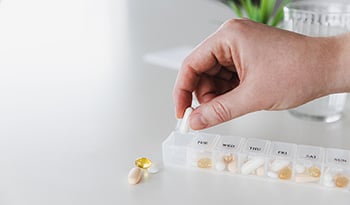Low Energy? Here are 5 Supplements for Mitochondria Health
DISCLAIMER:This blog does not intend to provide diagnosis...
- In this article:
- What Do Our Mitochondria Do?
- Mitochondria History
- What If My Mitochondria Aren’t Healthy?
- 5 Ways to Improve Mitochondrial Health
- 5 Supplements for Mitochondrial Health

Do you want to digest the food you just ate? You need energy. Do you want to exercise? You need energy. Do you want to watch your favorite TV show? Yes, even that requires energy. And the mitochondria throughout your body are the key to providing you this life-supporting energy.
What Do Our Mitochondria Do?
In each of our cells lives a system of organelles or small organs that carry on key body functions. Think of your cell as another small body inside your own body.
Mitochondria are organelles within our cells that produce energy or ATP to power every single function in our body.
Mitochondria History
Scientists believe that the first mitochondria dated back to two billion years ago. These tiny mini-organs used to live on their own. Theories suggest the first human-like cell was created when a bacteria-like cell engulfed mitochondria. This mitochondria then became the main energy source for the cell, and then through the history of evolution, became the main energy source for the entire body.1
What If My Mitochondria Aren’t Healthy?
If your mitochondria need some support, you may feel like you are wiped out, exhausted, and/or dragging through the day.
Often eating a nutrient-poor diet, not sleeping well, high-stress levels, and a sedentary lifestyle can contribute to mitochondria not producing enough energy for you.
Researchers now think that poor mitochondrial health may contribute to aging — feeling and looking tired, and may be tied to how slow or fast we age — inside or outside of our bodies.
Free radicals or reactive oxygen species are molecules created from normal breakdown of food; these compounds can cause damage to the mitochondria. A free radical’s main job is to steal energy from other cells because if it does, it becomes more stable. Unfortunately, when it steals energy, it damages the cell it takes the energy from. Thankfully, the body is able to process and remove these potentially damaging components.
We do have some control over these processes. A lot of it comes down to how well we treat our mitochondria.
5 Ways to Improve Mitochondrial Health
1. Low Carb Intake
When your blood sugar spikes, this can lead to weight gain and may increase inflammation, which can put a strain on our mitochondria, as dealing with increased inflammation in the body requires more energy. As a result, our mitochondria have to work harder.2
Keeping your carb intake low allows the mitochondria to burn fat for energy. This is a more efficient and healthy way to make energy. Often when mitochondria make energy out of carbohydrates, free radicals are made. These molecules can damage our cells, which may lead to premature aging.
Most foods in the middle aisles of the grocery store are highly processed and full of sugar that is sometimes hidden. Look for foods that are nutrient-dense or packed with vitamins and antioxidants. This means loading your plate with grass-fed meat, wild-caught fish, organic vegetables, avocados, nuts and seeds, and leafy greens. A lot of these foods are also rich in B vitamins, which help us to break down our food for energy and support normal levels of our stress hormone cortisol.
2. Fasting
Intermittent fasting can also support mitochondrial function, as it helps to reduce damaging free radicals. You can do this by compressing the time you eat to 8 hours and start eating in the middle of the day.
3. Exercise
Movement through high-intensity interval training (HIIT) helps to boost energy production by our mitochondria and helps prevent mitochondrial damage. When you engage in this type of exercise, not only does it help with muscle endurance, but it also increases the number of mitochondria that power those mitochondria.
4. Sleep
Getting good sleep, researchers suggest, can also preserve our mitochondria. Sleep is basically the time the body eliminates any damaging materials, including free radicals. Also, poor quality sleep can increase our cortisol, and cause more stress.
Adding meditation and massage to your routine can also reduce the formation of mitochondria damaging free radicals. This relaxation time can also help to reduce levels of our stress hormone cortisol, which can increase inflammation in the body and ultimately harm our mitochondria.3
5. Sunlight
Exposing your body to safe amounts of sunlight in moderation is a natural way to increase mitochondria production. Exposing yourself to cold can also stimulate mitochondria production. A quick burst of cold temperature in the shower or 30 seconds in winter weather can kick the production of mitochondria into high gear.
5 Supplements for Mitochondrial Health
Many supplements support healthy mitochondria, including magnesium, glutathione, alpha-lipoic acid, L-carnitine, and fish oil.
1. Magnesium
Magnesium is an essential element and the fourth most common mineral in the body. This element is found in your body's cells and connective tissues, including bone, muscle, and serum. Magnesium is a required substance for many different processes in the body, including over 300 enzymatic reactions.
Research has shown magnesium may be involved in processes such as energy production. Its proposed role as an essential cofactor to enzymes that create our energy molecule ATP makes it clear why our mitochondria can’t live without this mineral.4
Food sources of magnesium include nuts and seeds, whole grains, fish, seafood, beans, and dark green leafy vegetables.
2. Glutathione
Glutathione is an antioxidant made up of amino acids (small proteins) cysteine, glutamate, and glycine. This compound is found in plants, animals, fungi, and some bacteria. Basically, an antioxidant helps to protect our cells from any damaging molecules, like free radicals.
Glutathione is also present in our mitochondria. It plays a key role in keeping our mitochondria healthy as it serves as the gatekeeper, keeping damaging molecules out of mitochondria and serving to repair any damage done to these essential organelles.
Glutathione is also present in many protein-rich foods.
3. Alpha Lipoic Acid (ALA)
Alpha-lipoic acid is a compound found in every human cell. In fact, its location may be surprising. It’s actually made inside the mitochondria.
It is a key element to turn nutrients into energy, and it also has powerful antioxidant properties.
Alpha-lipoic acid is classified as an antioxidant, that can protect cells from damage and support a healthy metabolism. The body can make alpha-lipoic acid, but only in small amounts. So, most people turn to foods or supplements to get this essential nutrient.6
There are many food sources of alpha-lipoic acid. Red meat and organ meats like liver are good animal sources. Plants also contain alpha-lipoic acid. Some good sources are broccoli, tomatoes, spinach, and Brussels sprouts.
4. L-carnitine
L-carnitine is a nutrient and dietary supplement that plays a key role in the production of energy in your body. This compound is created from amino acids lysine and methionine. Its role is to transport fatty acids that you eat into your cells’ mitochondria.7
Once the fatty acids are transported into the mitochondria, they can be turned into energy. Your body can make L-carnitine, but in order to make enough, you also need plenty of vitamin C.
In addition to the L-carnitine produced in your body, you can also obtain small amounts by eating animal products like meat or fish for supplementation.
5. Fish Oil
Fish oil is essentially liquid fat from fish. Fish oil doesn’t come from all fish, but only ones that are naturally very oily like tuna or anchovies. Omega 3 fatty acids are the “good stuff” in fish oil. These fatty acids come in two forms: EPA and DHA. Research has shown that both forms have health benefits, including maintaining the health of your mitochondria.
The membrane or outer layer of our mitochondria is made of fats. Research has shown that supplementation with omega 3 fatty acids can support the structure of this membrane, theoretically making the mitochondria less likely to be damaged when its outer protective membrane is stronger. These fatty acids may also help the mitochondria produce energy more efficiently.8
The mitochondrion is an essential organelle found in every cell of the human body. It has a big job to produce the energy needed to keep the body moving. Thankfully, there are lifestyle and supplemental interventions we can use to keep our mitochondria healthy.
References:
- Friedman, J. R., & Nunnari, J. (2014). Mitochondrial form and function. Nature, 505(7483), 335-343.
- Missiroli, S., Genovese, I., Perrone, M., Vezzani, B., Vitto, V., & Giorgi, C. (2020). The Role of Mitochondria in Inflammation: From Cancer to Neurodegenerative Disorders. Journal of clinical medicine, 9(3), 740.
- Hannibal, K. E., & Bishop, M. D. (2014). Chronic stress, cortisol dysfunction, and pain: a psychoneuroendocrine rationale for stress management in pain rehabilitation. Physical therapy, 94(12), 1816-1825.
- Pilchova, I., Klacanova, K., Tatarkova, Z., Kaplan, P., & Racay, P. (2017). The Involvement of Mg2+ in Regulation of Cellular and Mitochondrial Functions. Oxidative medicine and cellular longevity, 2017, 6797460.
- Marí, M., Morales, A., Colell, A., García-Ruiz, C., & Fernández-Checa, J. C. (2009). Mitochondrial glutathione, a key survival antioxidant. Antioxidants & redox signaling, 11(11), 2685-2700.
- Ong, S. L., Vohra, H., Zhang, Y., Sutton, M., & Whitworth, J. A. (2013). The effect of alpha-lipoic acid on mitochondrial superoxide and glucocorticoid-induced hypertension. Oxidative medicine and cellular longevity, 2013, 517045.
- Marcovina, S. M., Sirtori, C., Peracino, A., Gheorghiade, M., Borum, P., Remuzzi, G., & Ardehali, H. (2013). Translating the basic knowledge of mitochondrial functions to metabolic therapy: role of L-carnitine. Translational research: the journal of laboratory and clinical medicine, 161(2), 73-84.
- Herbst, E. A., Paglialunga, S., Gerling, C., Whitfield, J., Mukai, K., Chabowski, A., Heigenhauser, G. J., Spriet, L. L., & Holloway, G. P. (2014). Omega-3 supplementation alters mitochondrial membrane composition and respiration kinetics in human skeletal muscle. The Journal of physiology, 592(6), 1341-1352.

 By Dr. Melissa Anzelone, N.D.
By Dr. Melissa Anzelone, N.D.


